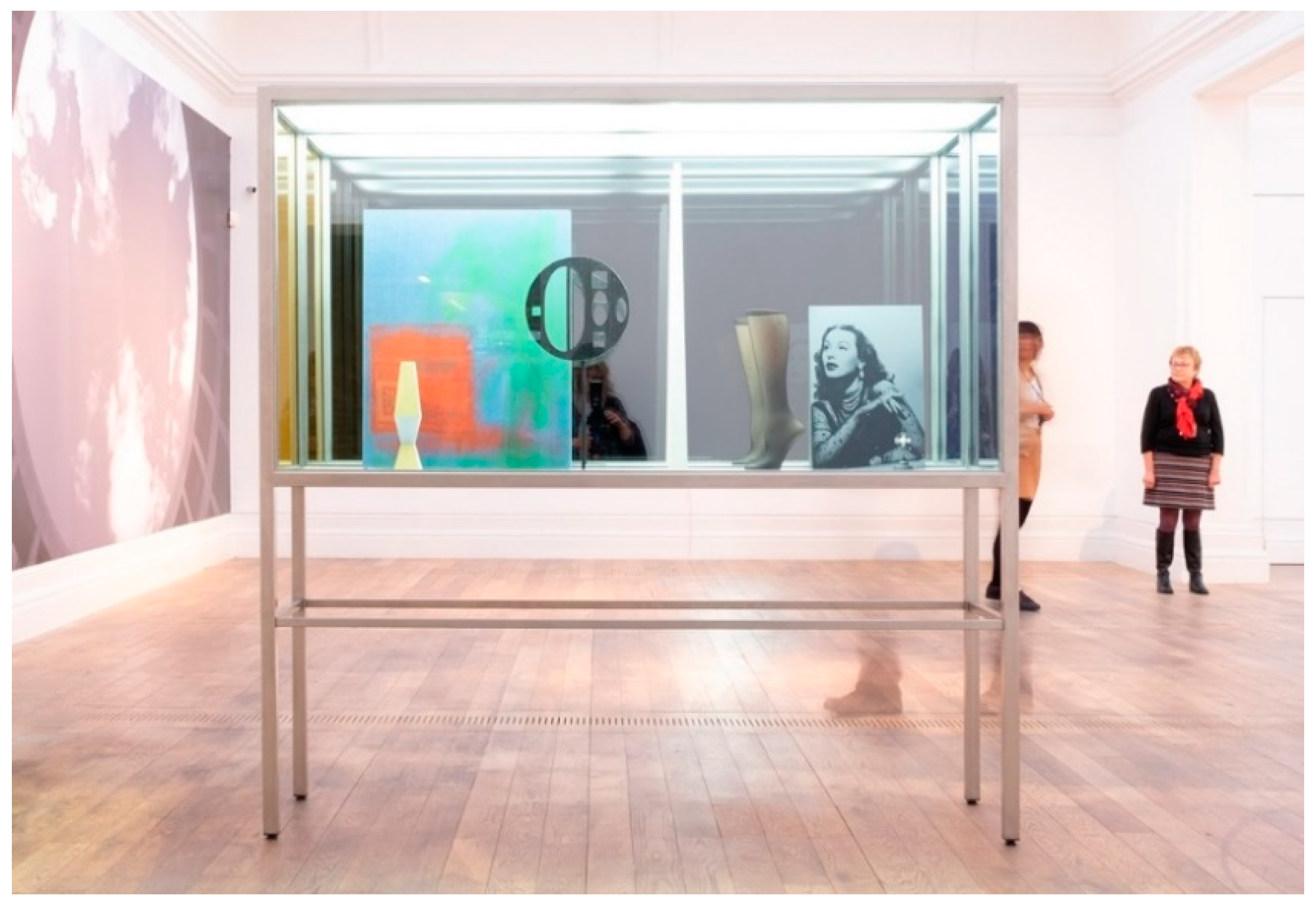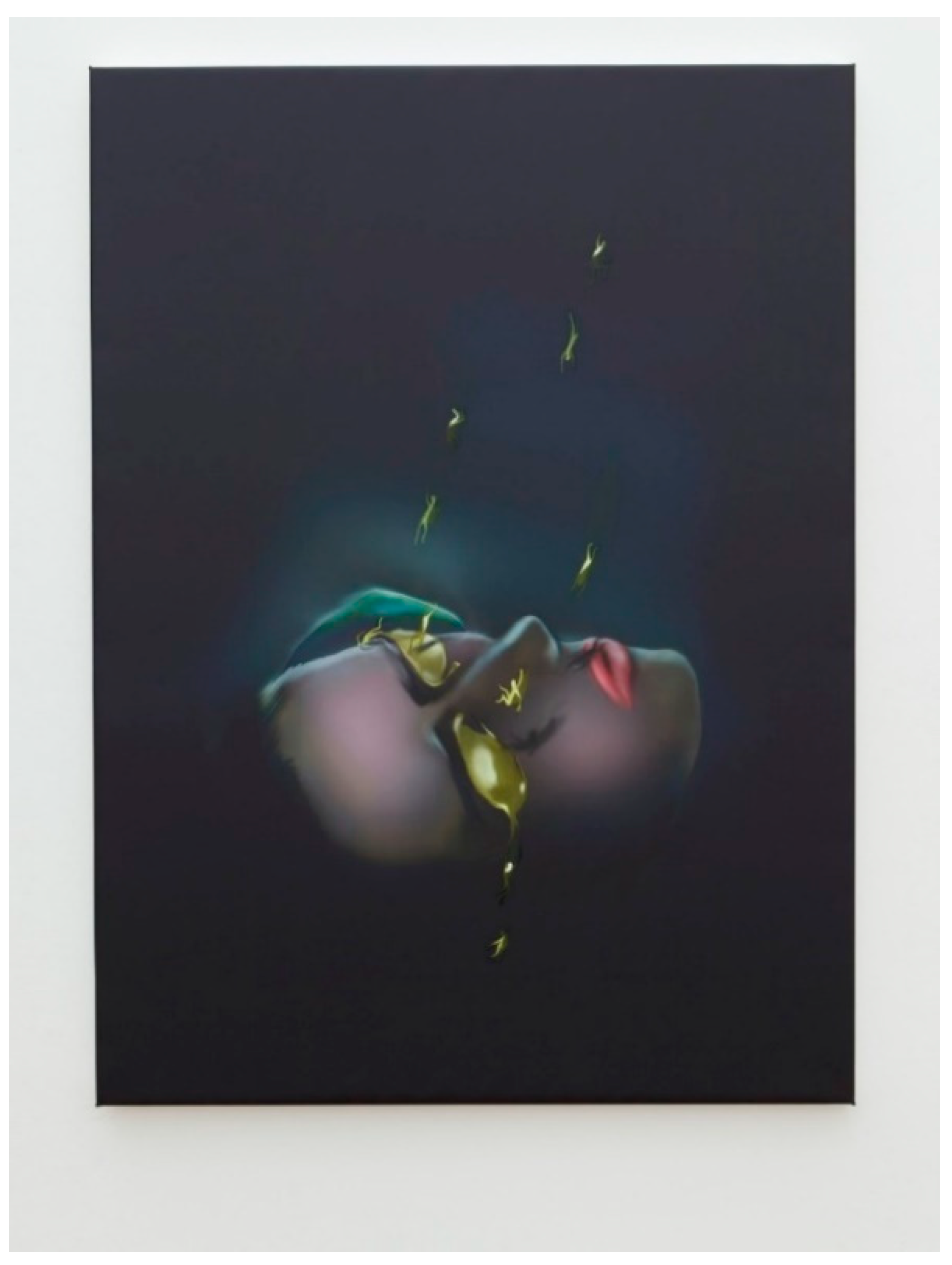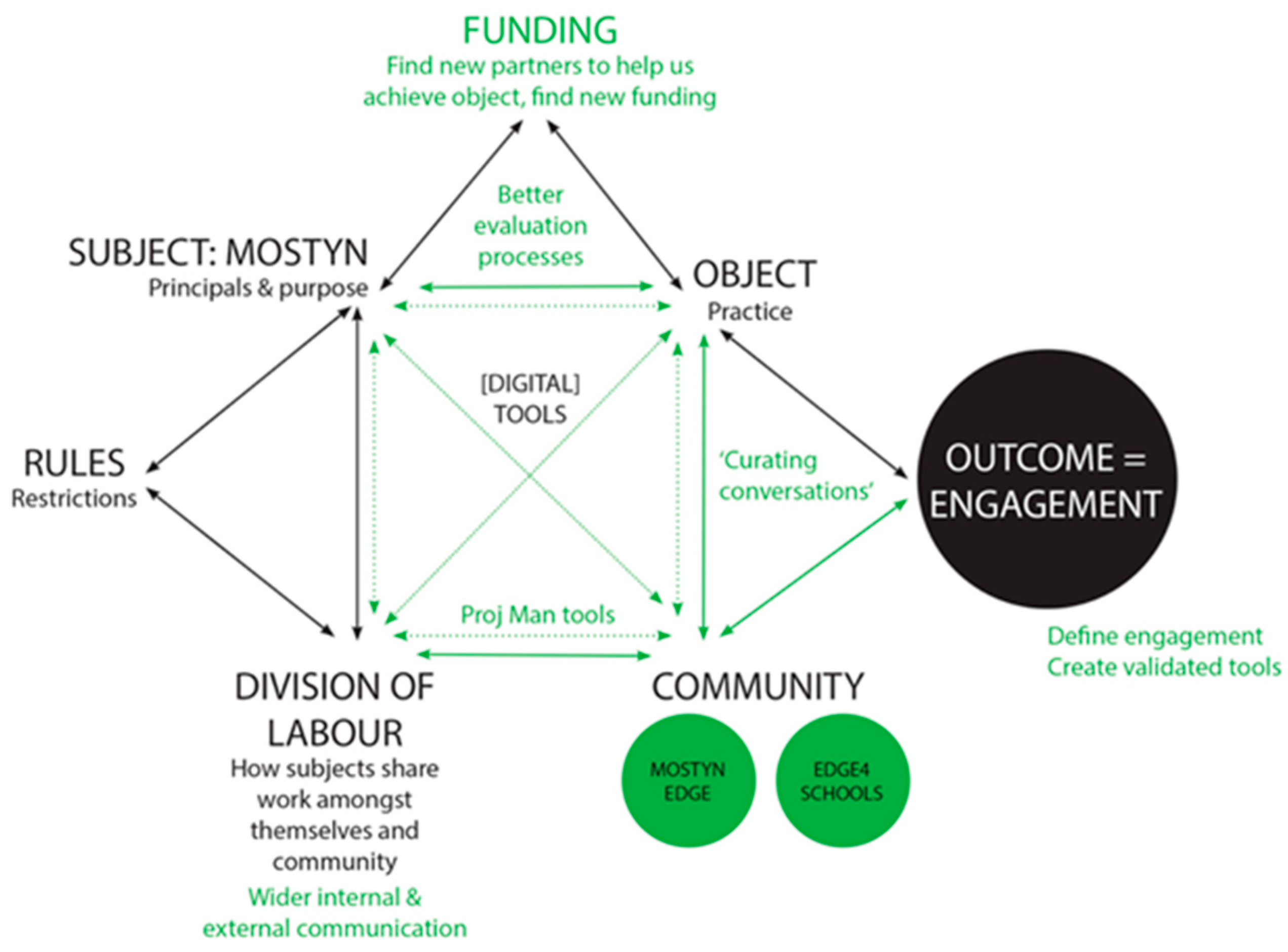Digital Engagement in a Contemporary Art Gallery: Transforming Audiences
Abstract
:1. Introduction
- “The Digital Shift”—The digital need as identified by arts bodies versus the lack of funding and the radical upskilling it will require presents challenges to arts organisations.
- “Digital Challenges”—How to define and explain the relationship between digital and traditional art practices and the context within which work is made to audiences of varying digital literacy.
- “Identifying Digital Potential”—How curators can take advantage of new ways of engaging with audiences, and considering MOSTYN as a case study of how a human-centred design (HCD) and an activity systems analysis approach has transformed audiences.
2. Discussion
2.1. The Digital Shift
2.2. The Digital Challenges
2.3. Challenges of Digital to Curators
2.4. Challenges of Digital to Cultural Organisations
3. Identifying the Digital Potential at MOSTYN
- A MOSTYN staff workshop role play and pilot public tasks before the research team facilitated
- A public workshop with 18 audience members, staff and stakeholders. Participation was voluntary following a call out via MOSTYN’s visitor database and social media. The workshop to deployed and tested multiple agile, lo-fi prototypes for tools that participants felt would improve their MOSTYN visitor experience. Insights were shared about their recent visits, experiences and knowledge of MOSTYN through a series of interactive tasks. Findings were then organised and ranked by participants to establish a hierarchy of needs. Lo-fi prototypes of possible solutions were then created, using cardboard, paper and string and these were presented to the rest of the group.
- A public consultation was held within MOSTYN to present the lo-fi prototypes to audiences for further comments, along with a small selection of tasks taken from the public workshop to triangulate findings.
- A rapid, intensive problem-solving design exercise (Design Sprint) was held with MOSTYN staff to take public ideas and insight and combine them with organisational need to develop a new digital interface within MOSTYN.
4. Conclusions
Author Contributions
Funding
Acknowledgments
Conflicts of Interest
References
- Archer, Michael, and Christiane Paul. 1997. Art Since 1960. London: Thames and Hudson, p. 7. [Google Scholar]
- Arts Council England. 2014. Digital Culture 2014: How Arts and Cultural Organisations in England Use Technology. Research Report. London: Digital R&D Funds for the Arts, Available online: https://www.artscouncil.org.uk/sites/default/files/download-file/Digital-Culture-2014-Research-Report2.pdf (accessed on 12 February 2019).
- Barthes, Roland. 1987. Image Music Text. London: Fontana Press. [Google Scholar]
- BrangerBriz.com. 2011. Available online: https://brangerbriz.com/portfolio/charge-for-privacy (accessed on 10 April 2019).
- Carr, Adam. 2018. Louisa Gagliardi Under the Weather. Exhibition Dates: 17 November 2018—3 March 2019 MOSTYN, Wales UK Gallery 3. Press Release. Available online: https://www.mostyn.org/exhibition/louisa-gagliardi-under-weather (accessed on 11 March 2019).
- Chan, Seb. 2016. Since We Last Spoke. Rounding up 2015. Available online: https://www.freshandnew.org/2016/01/roundup2015/ (accessed on 16 February 2019).
- Chayka, Kyle. 2012. How Open Source Is Disrupting Visual Art. Available online: https://www.vice.com/en_uk/article/wnzm4q/how-open-source-is-disrupting-visual-art (accessed on 20 February 2019).
- Cramerotti, Alfredo. 2018. Josephine Meckseper. Exhibition Dates: 17 November 2018—3 March 2019 MOSTYN. Press Release. Available online: https://www.mostyn.org/exhibition/josephine-meckseper (accessed on 5 February 2019).
- Cramerotti, Alfredo, and Adam Carr. 2017. Alfredo Cramerotti, Director, MOSTYN and Adam Carr—Visual Arts Programme Curator, MOSTYN Talk about the Latest in the ‘Conversation Series’ of Exhibitions, Showing from 22nd October 2016 until 5th February 2017. Available online: https://www.mostyn.org/exhibition/mladen-bizumic (accessed on 11 March 2019).
- Dawson, D., A. Grant, P. Miller, and J. Perkins. 2004. User Evaluation: Sharing Expertise to Build Shared Values. In Museums and the Web 2004: Proceedings. Edited by D. Bearman and J. Trant. Toronto: Archives and Museum Informatics, Available online: http://www.archimuse.com/mw2004/papers/dawson/dawson.html. (accessed on 11 March 2019).
- Digital R&D Fund for the Arts. 2014. Digital Culture 2014: How Arts and Cultural Organisations in England Use Technology. p 36, fig 10. Available online: www.artscouncil.org.uk/sites/default/files/downloadfile/Digital-Culture-2014-Research-Report2.pdf (accessed on 10 July 2019).
- Earnshaw, Rae. 2017. Art Design and Technology: Collaboration and Implementation. Switzerland: Springer, p. Viii Preface. [Google Scholar]
- Furtherfield Commons. 2019. Available online: https://www.furtherfield.org (accessed on 2 March 2019).
- Golant Media Ventures. 2018. The Adoption of Digital Technology in the Arts, on Behalf of the Digital Innovation Fund for the Arts in Wales. p. 6. Available online: https://media.nesta.org.uk/documents/difaw_gmv_e.pdf (accessed on 11 September 2018).
- Granjon, Paul. 2016. Paul Granjon Am I Robot? Exhibition at MOSTYN 24 September—16 October 2016. Available online: https://www.mostyn.org/exhibition/paul-granjon (accessed on 11 March 2019).
- Haley Goldman, Michael, and Kathryn Haley Goldman. 2005. Whither the Web: Professionalism and practices for the changing museum. In Museums and the Web 2005: Proceedings. Edited by David Bearman and Jennifer Trant. Toronto: Archives & Museum Informatics, Available online: http://www.archimuse.com/mw2005/papers/haleyGoldman/haleyGoldman.html (accessed on 11th March 2019).
- Hartley, Julian A. 2015. Museums and the Digital Public Space: Researching Digital Engagement Practice at the Whitworth Art Gallery. Ph.D. dissertation, University of Manchester, Manchester, UK; p. 14. Available online: https://ethos.bl.uk/OrderDetails.do?did=1&uin=uk.bl.ethos.677756 (accessed on 17 March 2019).
- Kaptelinin, Victor. 2005. The object of activity: Making sense of the sense-maker. Mind, Culture, and Activity 12: 4–18. [Google Scholar] [CrossRef]
- Krauss, Rosalind E., and Marcel Broodthaers. 1999. ‘A voyage on the North Sea’: Art in the Age of the Post-Medium Condition. London: Thames and Hudson. [Google Scholar]
- LungsProject.org. 2019. Available online: www.lungsproject.org (accessed on 2 February 2019).
- NBC News. 2019. Available online: https://www.nbcnews.com/business/consumer/trust-facebook-has-dropped-51-percent-cambridge-analytica-scandal-n867011 (accessed on 6 April 2019).
- Ofcom. 2015. Available online: https://www.ofcom.org.uk/about-ofcom/latest/media/media-releases/2015/cmr-uk-2015 (accessed on 6 March 2019).
- Ross, Claire Stephanie. 2014. Radical Trust Works: An Investigation of Digital Visitor Generated Content and Visitor Engagement in Museum Spaces. Ph.D. dissertation, University College London, London, UK. Available online: https://ethos.bl.uk/OrderDetails.do?did=1&uin=uk.bl.ethos.634698 (accessed on 17 March 2019).
- Walker, Dominic. 2015. Towards the Collaborative Museum? Social Media, Participation, Disciplinary Experts and the Public in the Contemporary Museum. Ph.D. dissertation, University of Cambridge, Cambridge, UK. Available online: https://ethos.bl.uk/OrderDetails.do?did=1&uin=uk.bl.ethos.681251 (accessed on 17 March 2019).
- The Whitworth Art Gallery. 2017. Whitworth Young Contemporaries: And Now We Are Plastic (January–April 2017). Manchester. Available online: https://www.whitworth.manchester.ac.uk/whats-on/exhibitions/pastexhibitions/wycandnowweareplastic/ (accessed on 20 March 2019).
- Vygotsky, Lev Semenovich. 1978. Mind in Society: The Development of Higher Psychological Processes. Cambridge: Harvard University Press. [Google Scholar]
- Yamagata-Lynch, Lisa C. 2007. Confronting Analytical Dilemmas for Understanding Complex Human Interactions in Design-Based Research from a Cultural-Historical Activity Theory (CHAT) Framework. The Journal of the Learning Sciences 16: 451–84. [Google Scholar] [CrossRef]
| 1 | |
| 2 | |
| 3 | Victoria and Albert Museum ‘Videogames: Design/Play/Disrupt’ exhibition (8 September 2018–24 February 2019). London. Available online: https://www.vam.ac.uk/articles/about-videogames-exhibition (accessed on 20 March 2019). |
| 4 |



© 2019 by the authors. Licensee MDPI, Basel, Switzerland. This article is an open access article distributed under the terms and conditions of the Creative Commons Attribution (CC BY) license (http://creativecommons.org/licenses/by/4.0/).
Share and Cite
Harding, C.; Liggett, S.; Lochrie, M. Digital Engagement in a Contemporary Art Gallery: Transforming Audiences. Arts 2019, 8, 90. https://doi.org/10.3390/arts8030090
Harding C, Liggett S, Lochrie M. Digital Engagement in a Contemporary Art Gallery: Transforming Audiences. Arts. 2019; 8(3):90. https://doi.org/10.3390/arts8030090
Chicago/Turabian StyleHarding, Clare, Susan Liggett, and Mark Lochrie. 2019. "Digital Engagement in a Contemporary Art Gallery: Transforming Audiences" Arts 8, no. 3: 90. https://doi.org/10.3390/arts8030090
APA StyleHarding, C., Liggett, S., & Lochrie, M. (2019). Digital Engagement in a Contemporary Art Gallery: Transforming Audiences. Arts, 8(3), 90. https://doi.org/10.3390/arts8030090




